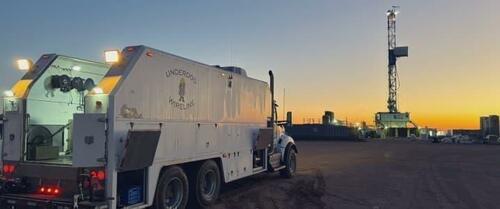
Peak Permian? Geology And Water Say We’re Close
Authored by Tsvetana Paraskova via OilPrice.com,
-
Some areas in the Permian have hit geological limits while others, yet to be drilled, are not expected to be as prolific as the prime Tier 1 acreage.
-
Despite record U.S. crude oil production, limits to growth have started to emerge.
-
In the Permian, the gas-to-oil ratio (GOR) has steadily risen from 34% of total production in 2014 to 40% in 2024.
After more than a decade of relentless drilling in the top U.S. oil-producing basin, the Permian, some areas have hit geological limits while others, yet to be drilled, are not expected to be as prolific as the prime Tier 1 acreage that producers have started to exhaust.

Top executives at major shale firms have already expressed opinions that Permian oil production could hit its peak as early as the end of this decade.
To be sure, crude oil output in the top basin continues to rise, but growth has slowed since 2022—not only because producers restrain capex and don’t drill themselves into oblivion.
Higher gas-to-oil ratio and water-to-oil ratio in the Permian suggest that some formations in the basin are reaching geological constraints, and more drilling isn’t necessarily proportionate to the oil volumes produced.
The Permian still leads U.S. oil production growth and will do so in the coming years, forecasters including the Energy Information Administration (EIA) say.
Total U.S. crude oil production is expected to average 13.61 million bpd this year, rising to 13.76 million bpd next year, according to the EIA’s latest Short-Term Energy Outlook.
Despite record U.S. crude oil production, limits to the growth have started to emerge, executives acknowledge.
Vicki Hollub, the chief executive of Occidental Petroleum, said at the CERAWeek conference early this month, “We think that between 2027 and 2030 it’s likely that the U.S. will see peak production, and after that some decline.”
Ryan Lance, CEO at ConocoPhillips, expects U.S. oil production to plateau this decade and remain flat for an undefined period of time after 2030.
“It’s going to be a slow decline beyond that because there’s a lot of resource” left to drill, Lance told the CERAWeek conference.
However, what’s left to drill may not be as oil-yielding as the best Permian locations, which were the first to be tapped by drillers.
Production of associated natural gas from the Permian, the Eagle Ford, and the Bakken oil wells has surged over the past decade, the EIA says.
In the Permian, the gas-to-oil ratio (GOR) has steadily risen from 34% of total production in 2014 to 40% in 2024.
Pressure within the reservoir declines as more oil is brought to the surface, which allows more natural gas to be released from the geologic formation. The pressure will also decrease as more wells are concentrated within an area, the EIA says.
Another ratio is even more suggestive of the Permian oil wells and the operating costs for drilling wells—produced water.
The water-to-oil ratio in the Permian is much higher than in other basins. On average, four barrels of water are produced for each barrel of oil, according to data from oilfield water analytics firm B3 Insight cited by Reuters.
While the Permian crude production is set to exceed 6.5 million bpd in 2025, up from more than 6 million bpd in 2024, the basin “is simultaneously generating an unprecedented volume of produced water—a costly and complex byproduct of hydrocarbon extraction,” B3 Insight said this week.
Crude-focused wells in the Permian account for the vast majority of the produced water generated in the leading U.S. shale plays, analysts at RBN Energy said last year.
The higher produced water ratio will ultimately drive costs for oil producers higher, according to Shannon Flowers, director of crude and water marketing at Coterra Energy.
“There are only so many places to drill, inject and frac, and as that goes down, you still have to find a home for the rest of your produced water,” Flowers told Reuters.
Higher costs to dispose of, reuse, or recycle produced water isn’t good news for U.S. oil producers who are already concerned with the U.S. Administration’s preference of a $50 a barrel oil price.
“There cannot be „U.S. energy dominance” and $50 per barrel oil; those two statements are contradictory. At $50-per-barrel oil, we will see U.S. oil production start to decline immediately and likely significantly (1 million barrels per day plus within a couple quarters),” an executive at an exploration and production firm wrote in comments to the Dallas Fed Energy Survey for the first quarter of 2025.
“The U.S. oil cost curve is in a different place than it was five years ago; $70 per barrel is the new $50 per barrel,” the executive noted.
Tyler Durden
Mon, 03/31/2025 – 13:40








![Sejm na żywo 2 kwietnia [Transmisja online]](https://webp-konwerter.incdn.pl/eyJmIjoiaHR0cHM6Ly9nLml/uZm9yLnBsL3AvX2ZpbGVzLz/M4NDAyMDAwL3Nlam0tMzg0M/DE2NjYuanBnIiwidyI6MTIwMH0.webp)



